Wild Macaws
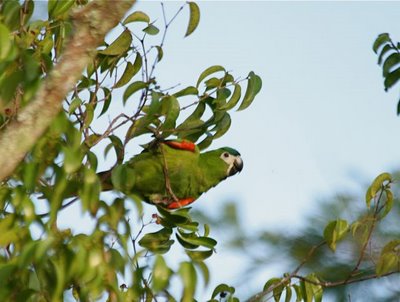 We're back in Guyana, as the snow pelts down like feathers in Ohio.
We're back in Guyana, as the snow pelts down like feathers in Ohio. A lot of people don't know that macaws come in other flavors than huge, red or blue. We've all seen the scarlet macaw with its yellow and blue wings, its lookalike cousin the green-winged macaw (also red, but with green and blue wings), and the blue and yellow macaw (ubiquitous in any advertisement for tropical anything; an icon of Jimmy Buffett's brand). Nearly three feet long, these species are a lotta bird.
But there's a whole spectrum of small macaws, the smallest being the red-shouldered macaw Diopsittaca n. nobilis. In the pet bird trade, D. nobilis is also known as the Hahn's or noble macaw. There are three subspecies in all; D. n. cumanensis has a horn-colored maxilla. The Guyanan subspecies, with its slate-colored maxilla, is D. n. nobilis. At 365 gm, my chestnut-fronted macaw Charlie weighs more than twice as much as a red-shouldered macaw : 165 gm (5.6) oz.
I've always thought that it's a short leap from the smallest macaws like the red-shouldered to the large conures such as the blue-crowned conure Aratinga acuticaudata, (made famous in the movie "Paulie.") But for a bit of bare facial skin, there's precious little difference in size, shape or behavior between macaws and conures.
Almost everywhere we went on the Guyanan coastal plain and even well into the savannah, we heard the harsh eek-eek-eek-ing of red-shouldered macaws. They travel in large flocks and they always seem to be feeding, ripping into palm fruits, as here, or mangoes (a later post).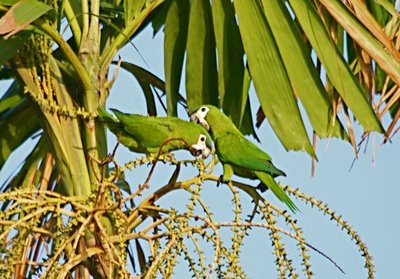 They're gorgeous, highly social, acrobatic little birds. Upside-down is just fine with them; they seem to be just as comfortable head-down as head-up. (Don't miss the bird in the upper left quadrant).
They're gorgeous, highly social, acrobatic little birds. Upside-down is just fine with them; they seem to be just as comfortable head-down as head-up. (Don't miss the bird in the upper left quadrant).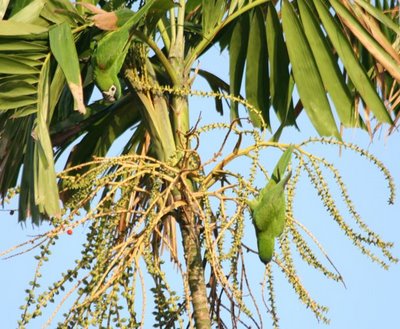
Here's one investigating the cannonball tree.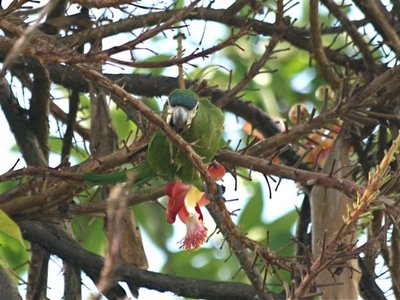
Macaws locomote by grabbing branches with the bill as you would your hand. They really seem to make up for not having hands with that bill.
A lot of these birds were acting "breedy," coming down in the lower canopy to investigate potential nest sites. I settled back to watch a pair that was apart from the flock and suspiciously low in a tree.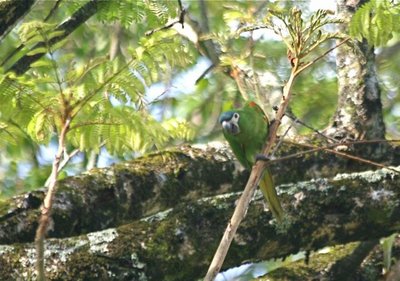 Here's the pair, and the object of their interest: the black cavity in the lower right corner of the photo.
Here's the pair, and the object of their interest: the black cavity in the lower right corner of the photo.
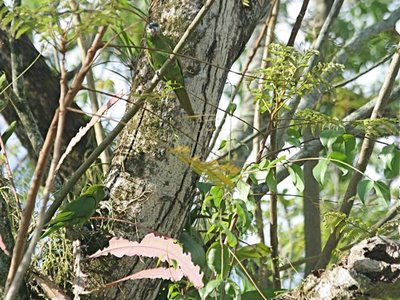 One bird tucked itself into the cavity, and the other followed to investigate.
One bird tucked itself into the cavity, and the other followed to investigate.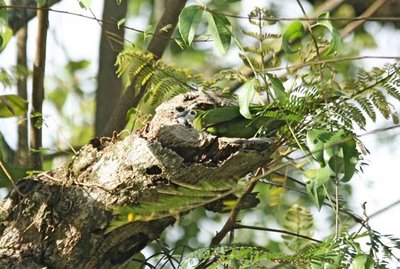
Catch those red "shoulders," actually lesser underwing coverts.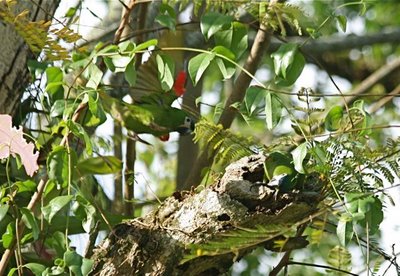
I left them in peace, not wanting them to think I knew where they might be nesting.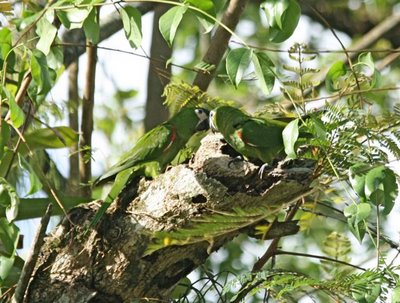
When you see big flocks of macaws, you're given to wonder how each pair manages to find a rotten tree cavity large enough to accomodate its nest. But there are a lot of oversized trees in the tropics, and a whole lot more rot than there is in temperate zones. Still, there are probably birds who fail to find a suitable cavity--they're nest-site limited. Makes you want to put up some macaw boxes. I can just imagine my yard if I lived in Guyana.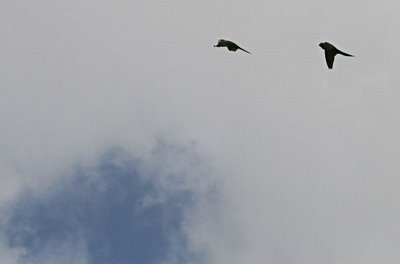
It would be full of macaws, flying free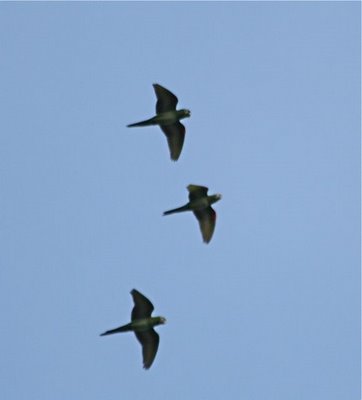
coming in to my palms and mangoes, getting a handout of fruit or seeds at my feeders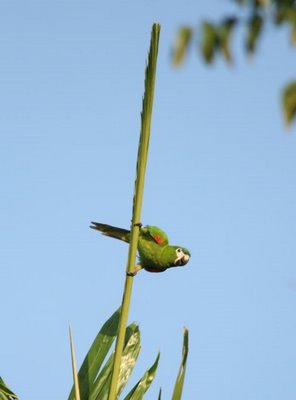
flashing golden wings.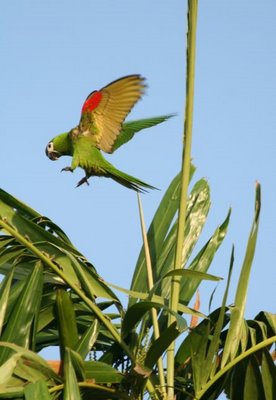
But there's a whole spectrum of small macaws, the smallest being the red-shouldered macaw Diopsittaca n. nobilis. In the pet bird trade, D. nobilis is also known as the Hahn's or noble macaw. There are three subspecies in all; D. n. cumanensis has a horn-colored maxilla. The Guyanan subspecies, with its slate-colored maxilla, is D. n. nobilis. At 365 gm, my chestnut-fronted macaw Charlie weighs more than twice as much as a red-shouldered macaw : 165 gm (5.6) oz.
I've always thought that it's a short leap from the smallest macaws like the red-shouldered to the large conures such as the blue-crowned conure Aratinga acuticaudata, (made famous in the movie "Paulie.") But for a bit of bare facial skin, there's precious little difference in size, shape or behavior between macaws and conures.
Almost everywhere we went on the Guyanan coastal plain and even well into the savannah, we heard the harsh eek-eek-eek-ing of red-shouldered macaws. They travel in large flocks and they always seem to be feeding, ripping into palm fruits, as here, or mangoes (a later post).
 They're gorgeous, highly social, acrobatic little birds. Upside-down is just fine with them; they seem to be just as comfortable head-down as head-up. (Don't miss the bird in the upper left quadrant).
They're gorgeous, highly social, acrobatic little birds. Upside-down is just fine with them; they seem to be just as comfortable head-down as head-up. (Don't miss the bird in the upper left quadrant).
Here's one investigating the cannonball tree.

Macaws locomote by grabbing branches with the bill as you would your hand. They really seem to make up for not having hands with that bill.
A lot of these birds were acting "breedy," coming down in the lower canopy to investigate potential nest sites. I settled back to watch a pair that was apart from the flock and suspiciously low in a tree.
 Here's the pair, and the object of their interest: the black cavity in the lower right corner of the photo.
Here's the pair, and the object of their interest: the black cavity in the lower right corner of the photo. One bird tucked itself into the cavity, and the other followed to investigate.
One bird tucked itself into the cavity, and the other followed to investigate.
Catch those red "shoulders," actually lesser underwing coverts.

I left them in peace, not wanting them to think I knew where they might be nesting.

When you see big flocks of macaws, you're given to wonder how each pair manages to find a rotten tree cavity large enough to accomodate its nest. But there are a lot of oversized trees in the tropics, and a whole lot more rot than there is in temperate zones. Still, there are probably birds who fail to find a suitable cavity--they're nest-site limited. Makes you want to put up some macaw boxes. I can just imagine my yard if I lived in Guyana.

It would be full of macaws, flying free

coming in to my palms and mangoes, getting a handout of fruit or seeds at my feeders

flashing golden wings.

Labels: birding in Guyana, blue-crowned conure, Hahn's macaw, Noble macaw, red-shouldered macaw






<< Home